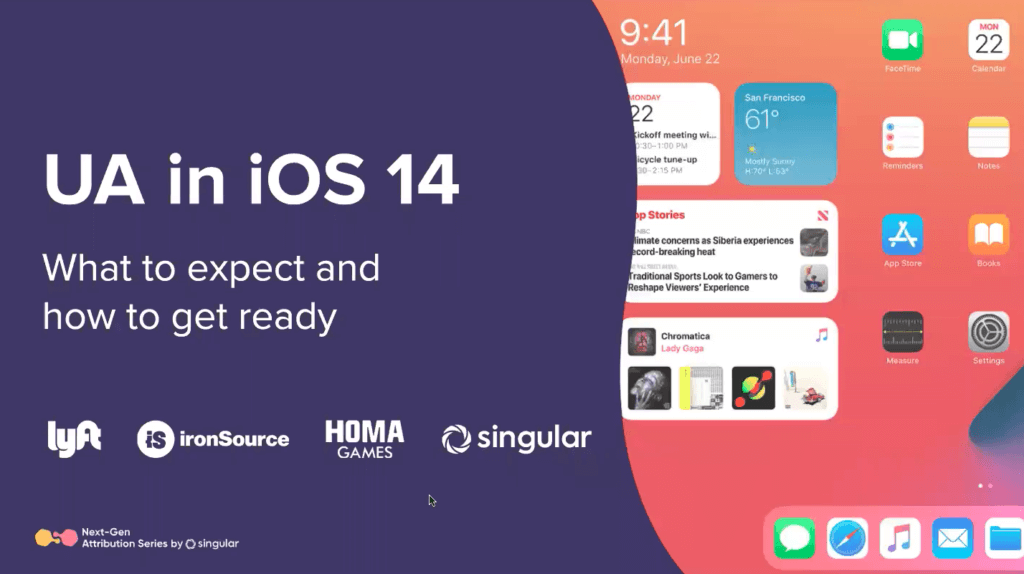How to rock user acquisition in iOS 14, with insight from Lyft, ironSource, and Homa Games
How to rock user acquisition in iOS 14, with insight from Lyft, ironSource, and Homa Games
User acquisition isn’t dead in iOS 14.
But it is changing dramatically.
“This is definitely an inflection point for the mobile app economy,” says ironSource VP of Growth, Yevgeny Peres. “The size of the pie might not change … but the way it’s going to be distributed will rely a lot on how each company addresses this change.”
iOS 14 and the much-forecasted death of the IDFA will happen in the next 40 days or so. Mobile-first companies that aren’t ready for this “earthquake” run the risk of losing ground to competitors. Marketing teams and user acquisition specialists who hit the ground running, however, stand to win the transition. The only question is: which are you?
There was definitely one big surprise in Singular’s recent iOS 14 user acquisition webinar:

The IDFA might not be dead after all.
As long as you ask for it in the right way, that is.
“Something you can test is to tell users if they allow tracking, the game will be free for them,” says Gonçalo Alemão Martins, who leads user acquisition and monetization for Homa Games, which publishes titles like the top-three game Tiny Cars. “Users become more familiar with what’s going to happen next, and it’s just not as much of a shock. And indeed … we saw this huge increase in allow tracking.”
That’s just one test Home Games did with a pre-IDFA ask pop-up, and they saw very positive results: between 70-80% opt-in. Many more tests will be required: others are seeing opposite results and ultimately what matters is what your users in your vertical do, as Lyft’s manager of growth platforms, Patrick McGrath, highlights.
“I would prioritize speed of testing and experimentation of new functionality because we don’t know what’s going to happen,” McGrath said in the iOS 14 user acquisition webinar. “It’s that fast sort of rapid iterative testing that’s going to uncover the new winning tactics and strategies.”
Other things to prepare for iOS 14?
Rethinking your campaign naming conventions because you only have 100 values for all of your campaigns in SKAdNetwork. Gaining a deep understanding of high user value predictors quickly, because you only have one post-install datapoint. Taking a close look at third-party single-sign-on solutions to ensure you’re not violating any Apple rules. And ensuring that your MMP handles SKAdNetwork for you.
There are still plenty of unknowns.
But what is clear right now is that the mobile marketing world is changing: moving away from granular data to aggregated data. And that deterministic data is still available.
“The thing we know is that fingerprinting, or let’s say probabilistic matching, will probably be a short-lived solution,” says Singular CEO Gadi Eliashiv. “It seems like Apple and other platforms have made pretty aggressive moves against that … and that’s something that as an industry we need to get adjusted to.”
That’s a quick overview of some of the highlights of the recent UA on iOS 14 webinar, but of course there’s much, much more. The entire webinar is available free and on-demand, and includes answers to the following questions, among others:
- How are companies getting ready for iOS14?
- Are marketers planning to pause UA when iOS 14 launches?
- Will marketers increase spend on Android?
- Will this increase monetization on Android?
- Will marketers use learnings on Android to inform UA decisions on iOS?
- Can UA specialists optimize collecting IDFAs by pre-requesting permission?
- How does the time component of SKAdNetwork delay the UA process?
- What does ad monetization look like post-iOS 14?
- What’s the impact of ad revenue?
- What is the impact of iOS 14 on BI stacks and growth stacks?
- Will Google follow Apple’s lead with GAIDs?
- How does SKAdnetwork work?
- What do you need to do to implement SKAdNetwork?
- How can advertisers map their post-install events to conversion values?
- What is Singular’s SKAN framework? What does it do?
- What are the top three practical things marketers should do right now?
Stay up to date on the latest happenings in digital marketing


